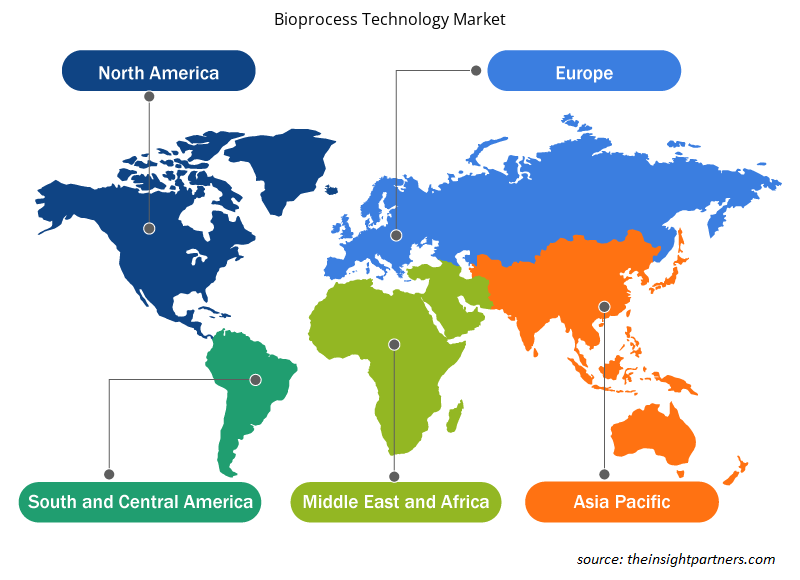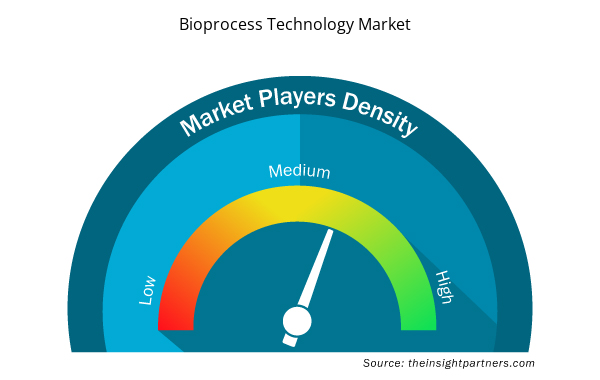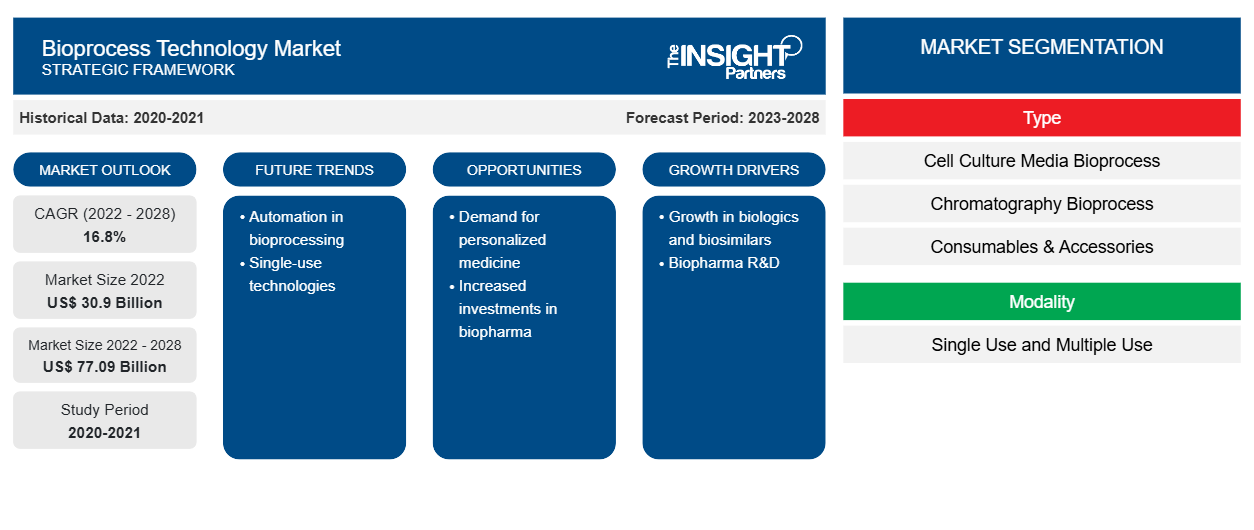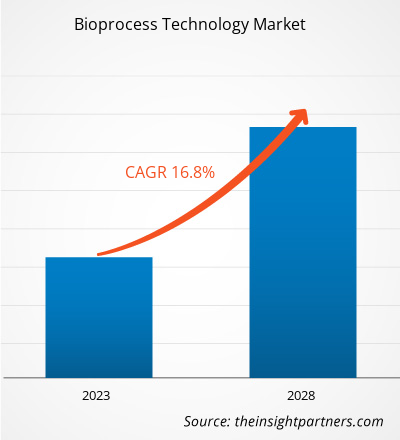[研究报告] 2022 年生物工艺技术市场规模价值 308.9749 亿美元,预计到 2028 年将达到 770.9005 亿美元;预计 2023 年至 2028 年的复合年增长率为 16.8%。
分析师观点
生物工艺的优势在于使用较低的压力、较低的温度和更有利的 pH 值,并且整个工艺都是可再生的。不断增加的研发支出用于引入新的药物化合物,以及慢性病的患病率不断上升。严格的监管政策是影响生物工艺技术市场增长的最重要因素。此外,引入先进的生物工艺技术为整个市场在预测期内呈指数级增长提供了有利可图的市场机会。此外,自动实时流式细胞术 (ART-FCM) 的出现是 2023-2028 年市场增长的未来趋势。根据报告中所述的细分,基于类型细分,细胞培养基生物工艺占最大份额;同样,色谱生物工艺预计在预测期(2023-2028 年)内将实现最高复合年增长率。此外,按方式划分,一次性使用部分将在预测期内占生物工艺技术的相当大份额。从最终用户的角度来看, 预测期内 ,生物制药公司部门将主导生物工艺技术市场的增长。
生物工艺技术是生物技术的重要组成部分,涉及将生物物质或其成分与营养物质相结合以生产特种化学品、试剂和生物治疗剂的过程。与生物工艺技术相关的不同阶段涉及底物和培养基制备、生物催化剂选择和优化、批量生产、下游加工、纯化和最终加工。生物工艺技术应用广泛,从食品和药品到燃料和化学品。
定制此报告以满足您的需求
您可以免费定制任何报告,包括本报告的部分内容、国家级分析、Excel 数据包,以及为初创企业和大学提供优惠和折扣
- 获取此报告的关键市场趋势。这个免费样品将包括数据分析,从市场趋势到估计和预测。
市场洞察
增加研发支出以推出新药
制药公司在研发上投入巨资,以推出具有增强医疗和商业潜力的新分子,用于各种治疗应用。在 2019/2020 财年,16 家制药公司在研发总投入方面跻身全球前 50 强公司之列。诺华、罗氏、强生、默克、葛兰素史克和辉瑞位列全球研发投入最高的前 10 家公司之列。
主要制药公司的研发投入
公司
|
2022 年研发投资(百万美元)
|
2021 年研发投资(百万美元)
|
吉利德科学公司 | 27,305 | 27,281 |
百时美施贵宝公司 | 46,159 | 46,385 |
安进公司 | 26,323 | 25,979 |
辉瑞 | 100,330 | 81,288 |
默克公司 | 59,283 | 48,704 |
艾伯维公司 | 58,054 | 56,197 |
注:凡有需要,均已考虑货币兑换率。
资料来源:公司年度报告和 Insight Partners 分析
畅销分子的专利到期、研发中潜在产品数量有限以及对生物制剂的需求不断增长,促使公司采用新技术,例如一次性生物加工技术,以便快速、经济高效地完成产品周转过程。一次性组件和系统制造商通常在洁净室中生产和组装产品,以确保不会将有害颗粒和内毒素引入生物工艺中。因此,公司在研发方面投入大量资金,以引入新的药物化合物并帮助开发生物加工技术;这些技术支持新兴的生物制造能力以及原材料、生物反应器和单元操作的相关互操作性。
基于类型的洞察
根据类型,生物工艺技术市场细分为细胞培养基生物工艺、色谱生物工艺、耗材和配件等。2022 年,细胞培养基生物工艺细分市场占据生物工艺技术的最大市场份额,而色谱生物工艺预计在预测期内(2023-2028 年)的复合年增长率最高。
基于模态的洞察
根据使用方式,全球生物工艺技术市场分为一次性使用和多次使用。2022 年,一次性使用部分在生物工艺技术中占据了较大的市场份额。预计在预测期内,多次使用部分将以更高的复合年增长率增长。
基于最终用户的洞察
就最终用户而言,生物工艺技术市场分为学术和医疗机构、生物制药公司、研究实验室等。生物制药公司部门在 2022 年占据最大市场份额,而学术和医疗机构预计在预测期内将实现更高的复合年增长率。
区域分析
北美占据生物工艺技术市场的大部分份额。该地区生物工艺技术市场的增长归因于大型企业推出创新产品(特别是与生物工艺技术相关的产品)、该地区产品引进的不断增长以及生物工艺技术的技术进步。在北美,美国在生物工艺技术方面占有最大份额。根据美国食品药品监督管理局 (FDA) 的报告,美国有超过 3000 万人患有约 7,000 种罕见疾病,这些疾病危及生命,且治疗选择较少。由于对罕见病历史缺乏了解,临床试验难以进行,治疗罕见病的药物、生物和设备开发具有挑战性。因此,基因和细胞疗法 (CGT) 和特种药物等生物工艺技术的发展代表了罕见病治疗的根本性转变。例如,与治疗罕见病的配方药物相比,CGT 显示出了显著的健康益处。在美国,针对基因治疗产品的 900 多项新药临床试验 (IND) 申请正在进行中。此外,FDA 每年批准 10-20 种基因疗法。同样,2022 年 8 月,FDA 批准了 Bluebird Bio 的“Zynteglo (betibeglogene autotemcel)”。这是美国最昂贵的单一用途药物批准,旨在治疗一种罕见的神经系统疾病——大脑肾上腺脑白质营养不良 (CALD)。
同样,亚太地区将占据生物工艺技术市场的最高复合年增长率。在亚太地区,中国将占据生物工艺技术市场相当大的市场份额。根据 BioPlan Associates 前 1000 家生物设施指数和生物制造商数据库报告,过去十年来,全球生物加工产能平均增长 12%。中国作为全球参与者,在小分子和大分子药物市场中占据有利地位,在全球分别占据第二和第三的位置。此外,由于中国拥有合同开发和制造组织 (CDMO) 基地,因此中国是多家细胞和基因治疗开发商的所在地,占该国生物生产能力的约 25%。因此,中国拥有相当大的生物制造能力,但严格遵守全球 GMP 标准,以建立对生物制剂安全性和有效性的信心。
国家
|
生物制造设施(L)
|
全球产能(%)
|
预计产能复合年增长率 (%)
|
中国 | 177万 | 10.2 | 15-20 |
来源:全球生物制造能力比较;数据来自 BioPlan Associates 前 1000 名生物设施指数和生物制造商数据库(CAGR = 复合年增长率)。
生物工艺技术市场区域洞察
Insight Partners 的分析师已详细解释了预测期内影响生物工艺技术市场的区域趋势和因素。本节还讨论了北美、欧洲、亚太地区、中东和非洲以及南美和中美洲的生物工艺技术市场细分和地理位置。

- 获取生物工艺技术市场的区域特定数据
生物工艺技术市场报告范围
| 报告属性 | 细节 |
|---|---|
| 2022 年市场规模 | 309亿美元 |
| 2028 年市场规模 | 770.9亿美元 |
| 全球复合年增长率(2022 - 2028) | 16.8% |
| 史料 | 2020-2021 |
| 预测期 | 2023-2028 |
| 涵盖的领域 | 按类型
|
| 覆盖地区和国家 | 北美
|
| 市场领导者和主要公司简介 |
|
生物工艺技术市场参与者密度:了解其对业务动态的影响
生物工艺技术市场正在快速增长,这得益于终端用户需求的不断增长,而这些需求又源于消费者偏好的不断变化、技术进步以及对产品优势的认识不断提高等因素。随着需求的增加,企业正在扩大其产品范围,进行创新以满足消费者的需求,并利用新兴趋势,从而进一步推动市场增长。
市场参与者密度是指在特定市场或行业内运营的企业或公司的分布情况。它表明相对于给定市场空间的规模或总市场价值,有多少竞争对手(市场参与者)存在于该市场空间中。
在生物工艺技术市场运营的主要公司有:
- 默克公司
- 赛多利斯公司
- 赛默飞世尔科技公司
- 康宁公司
- STAMM 生物技术
免责声明:上面列出的公司没有按照任何特定顺序排列。

- 了解生物工艺技术市场顶级关键参与者概况
默克集团、赛多利斯公司、赛默飞世尔科技公司、康宁公司、STAMM Biotech、龙沙集团、Eppendorf SE、Repligen Corp、丹纳赫公司和 BioPharma Dynamics Ltd 是全球生物工艺技术市场增长的主要参与者。报告分析了其他几家重要的市场参与者,以全面了解市场及其生态系统。该报告提供了详细的市场洞察,帮助关键参与者制定市场增长战略。以下提到了一些发展:
- 2022 年 6 月,默克与安捷伦科技公司达成合作,共同推进过程分析技术 (PAT)。PAT 受到全球监管机构的大力鼓励,是实时发布和生物加工 4.0 的关键推动因素。
- 2020 年 3 月,赛多利斯推出了 BIOSTAT STR 第三代一次性生物反应器和 BIOBRAIN 自动化平台,推出了将改变生物制药工艺开发和制造领域的创新。Biostat STR 简化了生物制剂的生产。
公司简介
- 默克公司
- 赛多利斯公司
- 赛默飞世尔科技公司
- 康宁公司
- STAMM 生物技术
- 龙沙集团
- 艾本德
- 瑞普利根公司
- 丹纳赫公司
- 生物制药动力有限公司
- 历史分析(2 年)、基准年、预测(7 年)及复合年增长率
- PEST 和 SWOT 分析
- 市场规模价值/数量 - 全球、区域、国家
- 行业和竞争格局
- Excel 数据集



Report Coverage
Revenue forecast, Company Analysis, Industry landscape, Growth factors, and Trends

Segment Covered
This text is related
to segments covered.

Regional Scope
North America, Europe, Asia Pacific, Middle East & Africa, South & Central America

Country Scope
This text is related
to country scope.
常见问题
Bioprocessing is the process that utilizes complete living cells or components (e.g., bacteria, enzymes, and proteins) to obtain desired products. The process is commonly known as fermentation. The entire process is divided into three stages: upstream process, fermentation, and downstream process. The upstream process involves preparation of liquid media, separation of particulate and inhibitory chemicals through sterilization and air purification. Additionally, fermentation involves the conversion of substrate to obtain desired products through biological agents such as microorganisms. Furthermore, downstream processing involves separation of cells from the fermentation broth, purification and concentration of desired products and waste disposal or recycle method.
The growing R&D spendings to introduce new drug compounds, and increasing prevalence of chronic diseases. However, stringent regulatory policies are restricting the market growth.
Based on type, cell culture media bioprocess took the forefront leaders in the worldwide market by accounting largest share in 2022 and is expected to continue to do so till the forecast period.
Global bioprocess technology market is segmented by region into North America, Europe, Asia Pacific, the Middle East & Africa, and South & Central America. In North America, the U.S. held the largest market share for bioprocess technology market. The US is expected to hold the largest share in the bioprocess technology market during the forecast period. The presence of top players and favorable regulations related to product approvals coupled with commercializing new products are the contributing factors for the regional growth. Additionally, the increasing number of technological advancements is the key factor responsible for the Asia Pacific regional growth in the coming years.
Merck KGaA, Sartorius AG, Thermo Fisher Scientific Inc, Corning Inc, STAMM Biotech, Lonza Group AG, Eppendorf SE, Repligen Corp, Danaher Corp, BioPharma Dynamics Ltd; are among the leading companies operating in the global bioprocess technology market
The single use segment dominated the global bioprocess technology market.
Trends and growth analysis reports related to Life Sciences : READ MORE..
The List of Companies - Bioprocess Technology Market
- Merck KGaA
- Sartorius AG
- Thermo Fisher Scientific Inc
- Corning Inc
- STAMM Biotech
- Lonza Group AG
- Eppendorf SE
- Repligen Corp
- Danaher Corp
- BioPharma Dynamics Ltd
The Insight Partners performs research in 4 major stages: Data Collection & Secondary Research, Primary Research, Data Analysis and Data Triangulation & Final Review.
- Data Collection and Secondary Research:
As a market research and consulting firm operating from a decade, we have published and advised several client across the globe. First step for any study will start with an assessment of currently available data and insights from existing reports. Further, historical and current market information is collected from Investor Presentations, Annual Reports, SEC Filings, etc., and other information related to company’s performance and market positioning are gathered from Paid Databases (Factiva, Hoovers, and Reuters) and various other publications available in public domain.
Several associations trade associates, technical forums, institutes, societies and organization are accessed to gain technical as well as market related insights through their publications such as research papers, blogs and press releases related to the studies are referred to get cues about the market. Further, white papers, journals, magazines, and other news articles published in last 3 years are scrutinized and analyzed to understand the current market trends.
- Primary Research:
The primarily interview analysis comprise of data obtained from industry participants interview and answers to survey questions gathered by in-house primary team.
For primary research, interviews are conducted with industry experts/CEOs/Marketing Managers/VPs/Subject Matter Experts from both demand and supply side to get a 360-degree view of the market. The primary team conducts several interviews based on the complexity of the markets to understand the various market trends and dynamics which makes research more credible and precise.
A typical research interview fulfils the following functions:
- Provides first-hand information on the market size, market trends, growth trends, competitive landscape, and outlook
- Validates and strengthens in-house secondary research findings
- Develops the analysis team’s expertise and market understanding
Primary research involves email interactions and telephone interviews for each market, category, segment, and sub-segment across geographies. The participants who typically take part in such a process include, but are not limited to:
- Industry participants: VPs, business development managers, market intelligence managers and national sales managers
- Outside experts: Valuation experts, research analysts and key opinion leaders specializing in the electronics and semiconductor industry.
Below is the breakup of our primary respondents by company, designation, and region:

Once we receive the confirmation from primary research sources or primary respondents, we finalize the base year market estimation and forecast the data as per the macroeconomic and microeconomic factors assessed during data collection.
- Data Analysis:
Once data is validated through both secondary as well as primary respondents, we finalize the market estimations by hypothesis formulation and factor analysis at regional and country level.
- Macro-Economic Factor Analysis:
We analyse macroeconomic indicators such the gross domestic product (GDP), increase in the demand for goods and services across industries, technological advancement, regional economic growth, governmental policies, the influence of COVID-19, PEST analysis, and other aspects. This analysis aids in setting benchmarks for various nations/regions and approximating market splits. Additionally, the general trend of the aforementioned components aid in determining the market's development possibilities.
- Country Level Data:
Various factors that are especially aligned to the country are taken into account to determine the market size for a certain area and country, including the presence of vendors, such as headquarters and offices, the country's GDP, demand patterns, and industry growth. To comprehend the market dynamics for the nation, a number of growth variables, inhibitors, application areas, and current market trends are researched. The aforementioned elements aid in determining the country's overall market's growth potential.
- Company Profile:
The “Table of Contents” is formulated by listing and analyzing more than 25 - 30 companies operating in the market ecosystem across geographies. However, we profile only 10 companies as a standard practice in our syndicate reports. These 10 companies comprise leading, emerging, and regional players. Nonetheless, our analysis is not restricted to the 10 listed companies, we also analyze other companies present in the market to develop a holistic view and understand the prevailing trends. The “Company Profiles” section in the report covers key facts, business description, products & services, financial information, SWOT analysis, and key developments. The financial information presented is extracted from the annual reports and official documents of the publicly listed companies. Upon collecting the information for the sections of respective companies, we verify them via various primary sources and then compile the data in respective company profiles. The company level information helps us in deriving the base number as well as in forecasting the market size.
- Developing Base Number:
Aggregation of sales statistics (2020-2022) and macro-economic factor, and other secondary and primary research insights are utilized to arrive at base number and related market shares for 2022. The data gaps are identified in this step and relevant market data is analyzed, collected from paid primary interviews or databases. On finalizing the base year market size, forecasts are developed on the basis of macro-economic, industry and market growth factors and company level analysis.
- Data Triangulation and Final Review:
The market findings and base year market size calculations are validated from supply as well as demand side. Demand side validations are based on macro-economic factor analysis and benchmarks for respective regions and countries. In case of supply side validations, revenues of major companies are estimated (in case not available) based on industry benchmark, approximate number of employees, product portfolio, and primary interviews revenues are gathered. Further revenue from target product/service segment is assessed to avoid overshooting of market statistics. In case of heavy deviations between supply and demand side values, all thes steps are repeated to achieve synchronization.
We follow an iterative model, wherein we share our research findings with Subject Matter Experts (SME’s) and Key Opinion Leaders (KOLs) until consensus view of the market is not formulated – this model negates any drastic deviation in the opinions of experts. Only validated and universally acceptable research findings are quoted in our reports.
We have important check points that we use to validate our research findings – which we call – data triangulation, where we validate the information, we generate from secondary sources with primary interviews and then we re-validate with our internal data bases and Subject matter experts. This comprehensive model enables us to deliver high quality, reliable data in shortest possible time.


 获取此报告的免费样本
获取此报告的免费样本